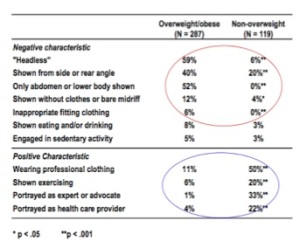I recently attended a big psychology conference and during a presentation on stigma and heath disparities, was saddened, but not surprised, to see yet another slide illustrated with an image of what Dr Charlotte Cooper calls the ‘headless fatty‘. These pictures – headless, shown from the back, spilling out of ill-fitting clothes, stripped to their skimpies, or simply a disembodied midriff – are dehumanising and stigmatising. They are rife in news coverage of ‘obesity’ and have been shown to increase anti-fat attitudes of readers.
It is astonishing how oblivious many of us are to these images. We have become so inured to seeing them, their presence almost de rigeur, that we don’t even notice they are there, let alone register the subliminal messages of individual blaming and shaming and neoliberal disgust that they carry. I have taken to challenging speakers who use these images to illustrate their slides – often, they will look blankly at me. They probably just googled ‘obesity soda tax’ and didn’t really pay much attention to what came up. Rarely does anybody admit to any wrongdoing in their use of these images. But but but. I’ve heard everything from ‘I just wanted to break up the text’ to ‘it’s kinder not to show people’s faces’. Because, you know, fat is just such a terrible thing to be. And besides, why should we pay models when we can snap gen-u-ine fat folks going about their daily business and use their images for free to titillate and outrage our readers/listeners.
Many of our lecturers are no better. I have seen these highly stigmatising visuals used to accompany classes in exercise science, nutrition, psychology, and others, or sometimes just for a bit of light relief. We know that anti-fat bias is high in qualified healthcare and exercise professionals, and that it appears to be getting worse. Studies in various types of healthcare students have shown that anti-fat attitudes actually worsen over the course of their training.
While being oblivious is not much of an excuse, possibly even worse is the deliberate use of fat-shaming humour. I have lost track of how many obesity, public health, bioethics, and even stigma researchers think these are a good way to lighten up the seriousness of their DeathFatz presentations. And clinicians – you know, those people who have actual professional relationships, supposedly, with actual real-life patients – often appear to see it is as their duty to share their contempt with their colleagues as a form of jovial professional bonding. Clearly I use the word ‘professional’ loosely here.
In case you have never really noticed this before, you might start to see it a bit more now – it’s kind of like the Emperor’s New Clothes. Once your eyes have been opened there is no going back. So here’s what I’d like you to do: Notice it. Speak up – not just for the benefit of the person who is using the images but for everyone else in the audience who may not have picked up on it either; or who did and felt too shamed to say anything. Let’s change the landscape.

Leave a comment